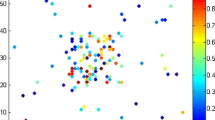Abstract
We present a simple simulation of road growing dynamics that can generate global features as belt-ways and star patterns observed in urban transportation infrastructure. The road growing dynamics consist of two steps: Identifying the maximum transportation potential bewteen two locations within the city, followed by the generation of the least expensive road between these two locations. The simulation defines a previously missing component for modeling the co-evolution of urban settlement- and road systems as it can directly be coupled to existing urban settlement simulations.
Similar content being viewed by others
References
Andersson, C., K. Lindgren, S. Rasmussen, and R. White. (2002). “Urban Growth Simulations from “First Principles.” Phys. Rev. E. 66, 026204.
Batty, M. and P. Longley. (1994). Fractal Cities. New York: Academic Press.
Batty, M. and Y. Xie. (1997). “Possible Urban Automata.” Env. and Plan. B 24, 173–192.
Benenson, I. and J. Portugali. (1997). “Agent-Based Simulations of a City Dynamics in a GIS Environment.” COSIT 501–502.
Benguigui, L. (1995). “A New Aggregation Model: Application to Town Growth.” Physica A 219, 13–26.
Benguigui, L. and M. Daoud. (1995). “Is the Suburban Railway System a Fractal?” Geog. Analy. 23, 362–368.
Candau, J., S. Rasmussen, and K.C. Clarke. (2000). “A Coupled Cellular Automaton Model for Land Use/Cover Dynamics.” In Proc. 4th Int. Conf. on Integrating GIS and Environmental Modeling (GIS/EM4) Banff, Alberta Canada, Sept. 2–8.
Church, R.L., S.R. Loban, and K. Lombard. (1992). “An Interface for Exploring Spatial Alternatives for a Corridor Location Problem.” Comp. and Geosciences 18(8), 1095–1105.
Clarke, K. and L. Gaydos. (1998). “Loose-Coupling a Cellular Automaton Model and GIS: Long-Term Urban Growth Prediction for San Francisco and Washington/Baltimore.” Int. J. Geographical Information Science 12(7), 699–714.
Clarke, K.C., S. Hoppen, and L. Gaydos. (1997). “A Self-Modifying Cellular Automaton Model of Historic Urbanization in the San Francisco Bay Area.” Env. and Plan. B 24(7), 247–261.
Couclelis, H. (1996). “From Cellular Automata to Urban Models: New Principles for Model Development and Implementation.” Artificial Worlds and Urban Studies, 165–190.
Ehlschlaeger, C.R. and A. Shortridge. (1996). “Modeling Elevation Uncertainty in Geographical Analyses.” In Proceedings of the International Symposium on Spatial Data Handling, 9B.15–9B.25.
Goodchild, M.F. (1977). “An Evaluation of Lattice Solutions to the Problem of Corridor Location.” Env, and Plan. A 9, 727–738.
Heiken, G., G. Valentine, M. Brown, S. Rasmussen, D. George, R. Greene, E. Jones, and C. Andersson. (2000). “Modeling Cities, The Los Alamos Urban Security Initiative.” Publ. Works Mang. and Policy 4(3), 198–212.
Lombard, K. and R.L. Church. (1993). “The Gateway Shortest Path Problem: Generating Alternative Routes for a Corridor Location Problem.” Geographical Systems 1, 25–45.
Makse, H.A., J.S. de Andrade, M. Batty, S. Havlin, and H.E. Stanley. (1998). “Modeling Urban Growth Patterns with Correlated Percolation.” Phys. Rev. E, 7059–7067.
Makse, H.A., S. Havlin, and H.E. Stanley (1995). “Modelling Urban Growth Patterns.” Nature 377, 608–612.
Miller, H.J. (1999). “Beyond the Isotropic Plane: Towards a Geospatial Analysis.” UCSB Spatial Analysis Workshop Papers.
Nagel, K., S. Rasmussen, and C. Barrett. (1997). “Network Traffic as a Self-Organized Critical Phenomenon.” In F. Schweitzer (ed.), Self-Organization of Complex Structures: From Individual to Collective Dynamics. Gordon and Breach, pp. 579–592.
Sanders, L., D. Pumain, and H. Mathian. (1997). “SIMPOP: A Multiagent System for the Study of Urbanism.” Env. and Plan. B 24, 287–305.
Schweitzer, F. (1997). “Active Walker Particles: Artificial Agents in Physics.” In L. Schimanski-Geier and T. Poschel (eds.), Stochastic Dynamics. Berlin: Springer Verlag, pp. 358–371.
Schweitzer, F., W. Ebelin, H. Rose, and O. Weiss (1998). “Optimization of Road Networks Using Evolutionary Strategies.” Evol. Comp. 5/4, 419–438.
Takeyama, M. (1996). “Geocellular: A General Platform for Dynamic Spatial Simulation.” Artificial Worlds and Urban Studies, 347–364.
http: //transims.tsasa.lanl.gov
http: //www.ees.lanl.gov/EES5/Urban Security/
White, R. and G. Engelen. (1997). “Multi-Scale Spatial Modelling of Self-Organizing Urban Systems.” In F. Schweitzer (ed.), Self-Organization of Complex Structures: From Individual to Collective Dynamics. pp. 519–535.
White, R., G. Engelen, and I. Uljee (1997). “The Use of Constrained Cellular Automata for High-Resolution Modeling of Urban Landscape Dynamics.” Env. and Plan. B 24, 323–343.
Wu, F. (1998). “SimLand: A Prototype to Simulate Land Conversion Through the Integrated GIS and CA with AHP-Derived Transition Rule.” Int. J. Geog. Info. Sci 12, 63–82.
Xie, Y. (1996). A Generalized Model for Cellular Urban Dynamics.” Geographical Analysis 28, 350–373.
Yang, H. (1998). “Models and Algorithms for Road Network Design: A Review and Some New Developments.” Transport Rev. 18(3), 257–278.
Author information
Authors and Affiliations
Rights and permissions
About this article
Cite this article
Yamins, D., Rasmussen, S. & Fogel, D. Growing Urban Roads. Networks and Spatial Economics 3, 69–85 (2003). https://doi.org/10.1023/A:1022001117715
Issue Date:
DOI: https://doi.org/10.1023/A:1022001117715




